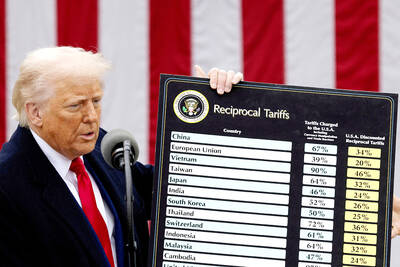China will unveil a range of unknown missiles during its Oct. 1 National Day parade, including intercontinental ballistic nuclear missiles, state media said yesterday.
The new hardware on display will include conventional cruise missiles and short and medium-range missiles, the Global Times newspaper reported, citing an unnamed source in the People’s Liberation Army (PLA).
“These missiles are domestically designed and manufactured and have never been officially reported before,” the source, who is with the PLA’s strategic missile defense unit, was quoted as saying.
The weapons have already been distributed to the military and are ready for operation, the source said.
China’s missile program is causing concern overseas, particularly in the US, amid projections that it could soon tip the security balance in the Taiwan Strait.
A report last month by the Rand Corporation, a US think tank, said China was increasing both the quantity and quality of its short-range ballistic missiles, which could challenge the US’ ability to protect Taiwan from possible attack.
China issued a military policy white paper earlier this year, saying its missile program was aimed mainly at “deterrence.”
However, it said that it was also capable of “conducting nuclear counter-attacks and precision strikes with conventional missiles.”
China will stage a huge military parade and pageant in Beijing on Oct. 1 to celebrate the 60th anniversary of the founding of communist China.
The expert quoted by Global Times did not reveal the model names or numbers of the missiles. However, missiles believed to have been developed by China include the Dong Feng 41, a solid-fuel intercontinental ballistic missile (ICBM) with an estimated range of up to 12,000km.
Meanwhile, the Wall Street Journal (WSJ) reported on Tuesday that China was redoubling efforts to build a fifth-generation fighter plane equivalent to the US’ F-22 and F-35. During the 60th anniversary of the PLA Navy in April, the commander of the PLA Navy mentioned a requirement for a fighter capable of “supersonic cruise,” which refers to an aircraft’s ability to fly supersonically for extended periods without using fuel-hungry afterburners.
China’s development of fifth-generation aircraft date back to the early 1990s, the WSJ said, and will start with two heavy fighters from the country’s two main military aircraft companies.
A Chinese source told the WSJ in early 2005 that the Chengdu Aircraft Corporation, which developed the fourth-generation J-10 fighter, was considering the development of a medium-weight fifth-generation aircraft comparable to the F-35. Shenyang Aircraft Corporation, meanwhile, said in 2006 it was working on a single-engine forward-swept-wing fighter that would be highly maneuverable and potentially stealthy, the WSJ said.
Advances in electronics and engines in China’s earlier-generation aircraft will make these fighters, as well as fifth-generation fighters, more threatening to current and future US air forces, and make obsolete the fourth-generation fighter aircraft used by Japan, South Korea and Taiwan, the WSJ said.

Rainfall is expected to become more widespread and persistent across central and southern Taiwan over the next few days, with the effects of the weather patterns becoming most prominent between last night and tomorrow, the Central Weather Administration (CWA) said yesterday. Independent meteorologist Daniel Wu (吳德榮) said that based on the latest forecast models of the combination of a low-pressure system and southwesterly winds, rainfall and flooding are expected to continue in central and southern Taiwan from today to Sunday. The CWA also warned of flash floods, thunder and lightning, and strong gusts in these areas, as well as landslides and fallen

WAITING GAME: The US has so far only offered a ‘best rate tariff,’ which officials assume is about 15 percent, the same as Japan, a person familiar with the matter said Taiwan and the US have completed “technical consultations” regarding tariffs and a finalized rate is expected to be released soon, Executive Yuan spokeswoman Michelle Lee (李慧芝) told a news conference yesterday, as a 90-day pause on US President Donald Trump’s “reciprocal” tariffs is set to expire today. The two countries have reached a “certain degree of consensus” on issues such as tariffs, nontariff trade barriers, trade facilitation, supply chain resilience and economic security, Lee said. They also discussed opportunities for cooperation, investment and procurement, she said. A joint statement is still being negotiated and would be released once the US government has made

SOUTH CHINA SEA? The Philippine president spoke of adding more classrooms and power plants, while skipping tensions with China over disputed areas Philippine President Ferdinand Marcos Jr yesterday blasted “useless and crumbling” flood control projects in a state of the nation address that focused on domestic issues after a months-long feud with his vice president. Addressing a joint session of congress after days of rain that left at least 31 dead, Marcos repeated his recent warning that the nation faced a climate change-driven “new normal,” while pledging to investigate publicly funded projects that had failed. “Let’s not pretend, the people know that these projects can breed corruption. Kickbacks ... for the boys,” he said, citing houses that were “swept away” by the floods. “Someone has

‘CRUDE’: The potential countermeasure is in response to South Africa renaming Taiwan’s representative offices and the insistence that it move out of Pretoria Taiwan is considering banning exports of semiconductors to South Africa after the latter unilaterally downgraded and changed the names of Taiwan’s two representative offices, the Ministry of Foreign Affairs (MOFA) said yesterday. On Monday last week, the South African Department of International Relations and Cooperation unilaterally released a statement saying that, as of April 1, the Taipei Liaison Offices in Pretoria and Cape Town had been renamed the “Taipei Commercial Office in Johannesburg” and the “Taipei Commercial Office in Cape Town.” Citing UN General Assembly Resolution 2758, it said that South Africa “recognizes the People’s Republic of China (PRC) as the sole